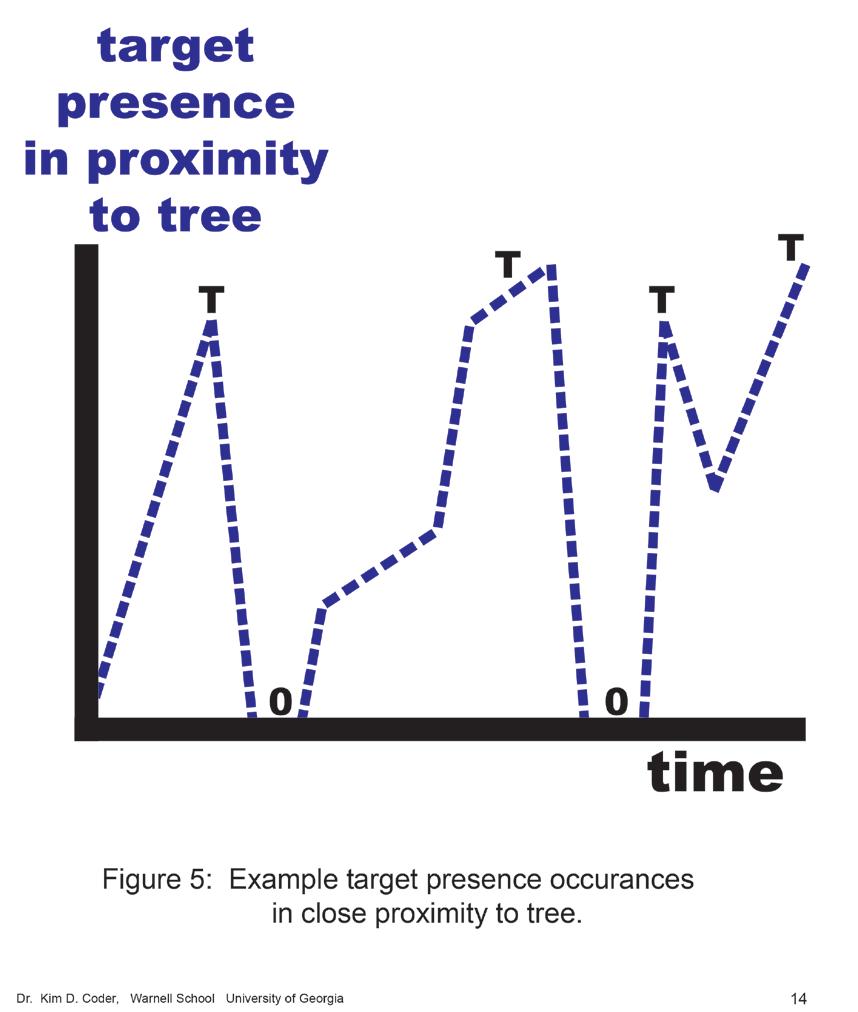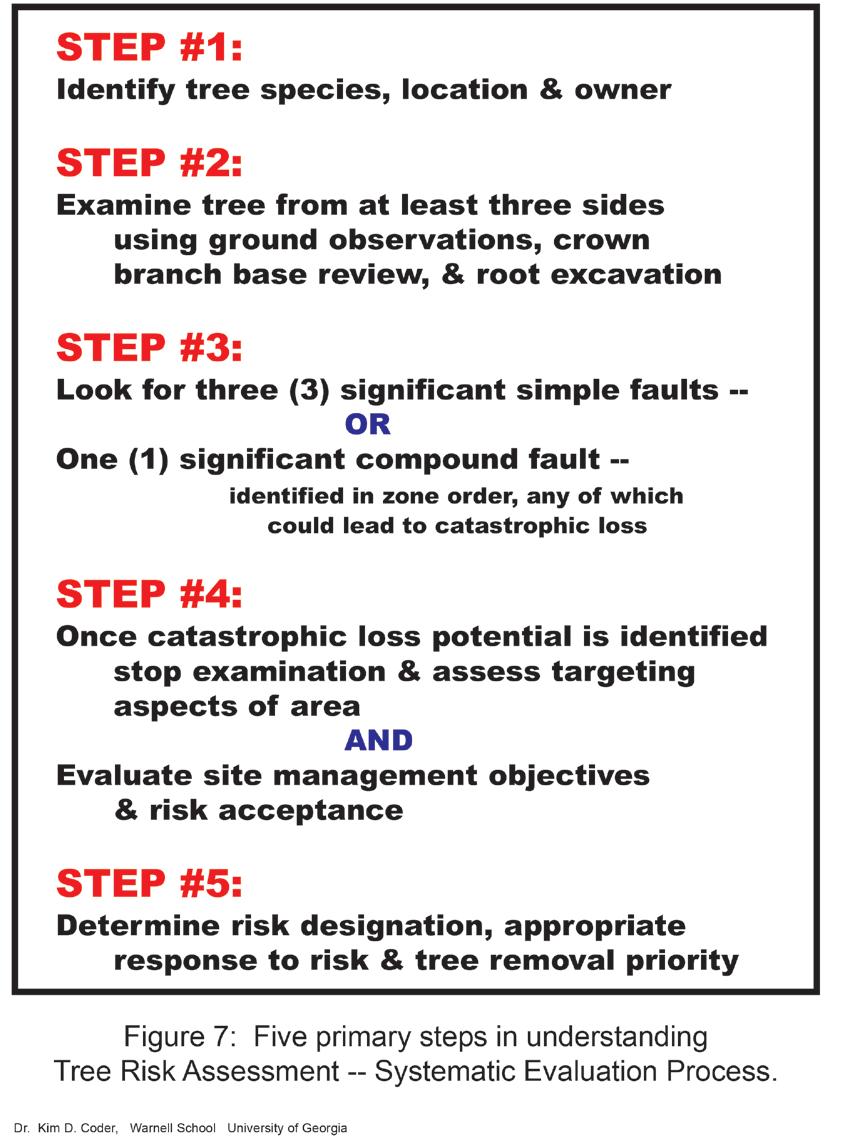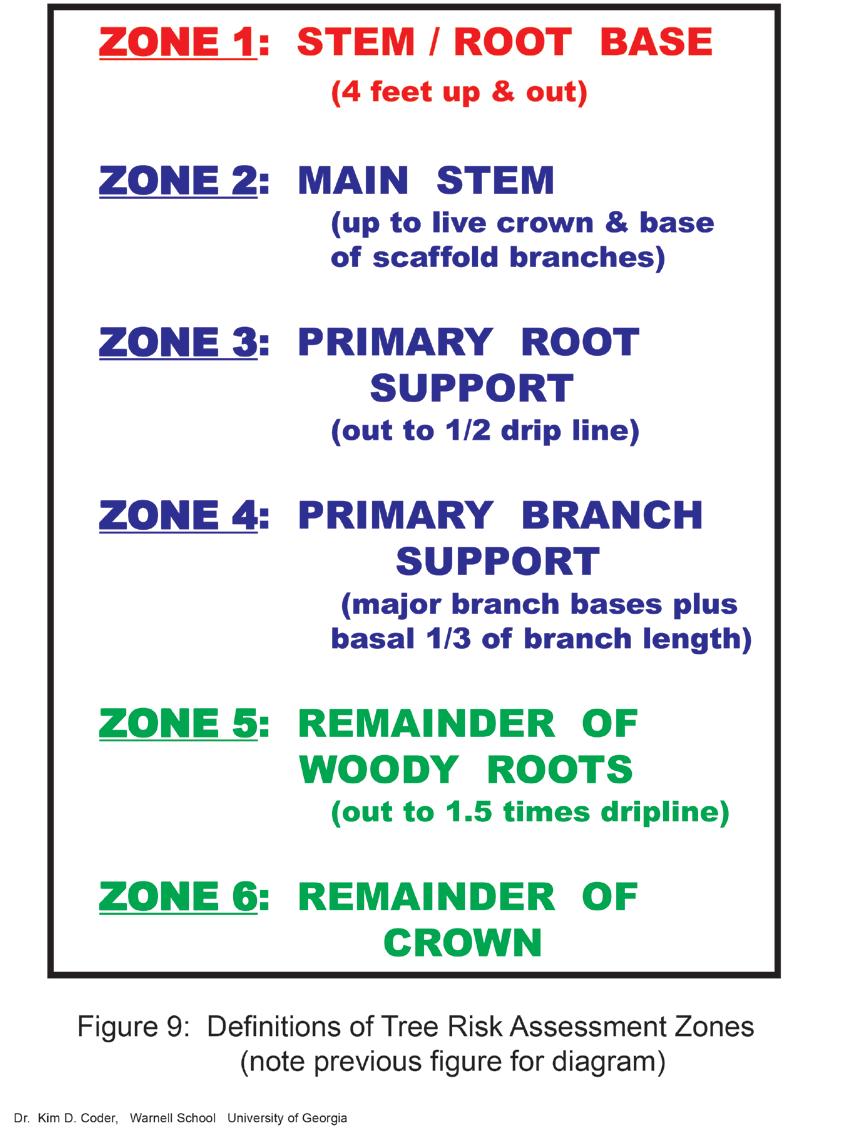
11 minute read
Managing community forests, part 2 Risk hazard and assessment
Managing community forests, part 2
Tree risk and hazard assessment concepts
by Dr. Kim D. Coder, Professor of Tree Biology & Health Care, Warnell School, UGA
Did you miss part 1 of this article? Check out the Spring 2019 UAC Magazine. Past issues can be accessed by UAC members at any time. Just log in as a member at urbanagcouncil.com.
Professional observations
The amount of tree damage visible while still allowing a tree to remain is a professional judgement. Several systems and rules have been developed to assist professionals. Some standards have suggested when 1/2 the stem circumference is damaged, a tree should be considered for removal. From a mechanical structure standpoint, this is not risk-conservative enough. Once circumferential damage reaches 1/3 or more, removal should be considered. Err on the side of safety.
Examining trees must concentrate on determining structural integrity, not surface appearance. Small faults lay-people might consider significant should be examined for structural consequences, but discarded if found to be only a blemish. Find what is the most limiting structural component in the tree and then estimate risks associated with its failure. Experience of the assessor is critical to risk management evaluations. Do not send inventory counters to make risk assessments without training, practice, and spot-checking their performance.
Structural failures in trees can generally be summarized as 40% in branches, 30% in stems, and 30% in root crowns and roots.
This near-even distribution suggests several things to a tree professional. The first is trees are structurally designed not to fail at any given point more than any other. Trees are well equipped to handle stress and strain in their environments. The second suggestion is common failure patterns need to be learned and expectations developed for prudent management. Careful observation is needed over all parts of a tree to effectively summarize risk levels.

Target risks
Once structural concerns have been reviewed, determine the second piece of a potential hazard tree assessment, which is presence of a target(s). Risk assessment targets are people and property. Anywhere people would walk, drive, stand, lay, run, recreate, etc. could be a target area. Sidewalks, streets, parking lots, ball fields, golf courses and parks are all prime target areas. Property targets most often damaged by trees are cars, fences, buildings, roofs, pavement, yards, and gardens. Personal injury targets and property targets are usually interrelated. At the very least, minimize risk to all personal injury targets.
There are many types or classes of targets. Some risk management systems try to prioritize management activities by target risk class. This type of target classification is dangerous in community forest risk assessment. Because of legal views of prudent and reasonable behavior by a manger, the only reasonable means of prioritizing by target are people vs. property. The more people, or the more valuable the property, the more target exposure. Figure 5 shows how non-static (usually people/animals and their conveyances) risk components change over time. Figure 6 combines structural and target risks. Note there is usually an inverse relationship between these two risk sources. At specific times when trees are most likely to fail (heavy wind loads), targets have departed or have been minimized.
Legal responsibilities
The legal framework for working with tree risks and structural failure varies by location. A community forest manager should always seek professional legal advice when needed. The framework of negligence, injury, and legal tests for prudence and reasonableness are important for understanding implications of risk. Here will be a brief review of general legal components of risks management and hazards assessment in a community forest.
For community forest managers, actions (and non-actions) will be judged for prudence, (which is the wisdom to look ahead and develop expectations about what can happen), and reasonableness, (which is the lack of negligence). A manager’s decisions must meet both of these tests under risk management programs, with the major point of contention being negligence.
Negligence
In a general sense, negligence is composed of four features which must all be true for negligence to be proved. These four features of negligence are: 1 You have a duty to exercise reasonable care; 2 You failed in that duty; 3 Failure in duty caused injury; and, 4 Injury caused real harm to people and /or property. The critical first step is determining your duty under the law.
Duty concepts
Case law and common law has delineated a difference between duty principles in rural versus urban settings. Traditionally in rural settings, an owner/manager had a duty to correct or remove known hazards. Duty principles continue to evolve, but generally suggest a greater level of duty in urban/ suburban areas. In urban areas, duty has included removal of known hazards and, in addition, inspection for hazards.
Inspection for hazards is a burden which must be met to prevent a failure in duty and charge of negligence.
The heightened duty in urban/suburban areas carry over into areas where tree failures could impact roads and trails.
Failure in duty can be substantiated by expert testimony and/or by not following customary practice without clear and substantial reasons. This suggests failing to follow ANSI-type national consensus standards and associated BMPs would play a part in determining negligence. Ignorance by the manager or
inspector is always challengeable. The action or lack of action can be questioned and supported by expert testimony for examining negligence.
One defense which falsely seems to comfort managers and owners is “act of God.” This defense used with hazard trees is challengeable and dependent upon two tests.
To use the act-of-God concept in denying liability, a tree must be a native tree planted by nature, and a tree must never have been significantly influenced by humans. Few trees in community and yard settings meet these two tests. Act-of-God has not proven to be an effective defense for negligence determinations.
Court recommendations
As a manager, the court asks two basic questions after a catastrophic tree structural failure: 1 “Were the managers negligent or was the tree a nuisance?” and, 2 “Would the hazard have been recognized upon inspection?” As a resource manager, you should be prepared to answer and support your answers, for any actions or inactions, you may have taken.
What do the courts recommend managers do to minimize liability risks? Three action items arise continually: 1 perform a timely systematic inspection and keep it current; 2 develop written documentation of risk management concerns; and, 3 use risk assessment inspection results in current and future management. In many circumstances, a lack of a systematic inspection could be considered negligence.
Systematic inspection
Systematic inspection demands observational discipline. The inspector must carefully examine a tree and make cumulative decisions about tree defects and associated target attributes. An inspection process should ideally include a root collar excavation, an aerial examination, and soil probing. Usually, some form of groundbased observation is used for cost-effectiveness.
Only tree professionals experienced in risk assessment should perform these evaluations. General tree inventory crews may not be technically or experientially qualified to examine trees and sites for risk levels.
To fulfill legal aspects of a systematic inspection for risk factors, a precise and accurate methodology must be used. A training system is presented here which has been proven to assist risk assessors and new students unfamiliar with tree risk assessments in five steps. Figure 7 provides the five steps used. Appendix 1 following this article provides an assessment form.
The basic tenet of this training system is concentrated around structural integrity observations which begin where stress and strain on a tree are greatest. Figure 8 and Figure 9 provides tree risk examination zones identified

by number. Inspections begin at the tree base in zone 1 and expand outward and upward in zone order.
No drive-by assessments!
An inspection should begin with a general overview of tree structural integrity to provide for the personal safety of the inspector, and the people and property in the immediate area at the time of inspection. From a distance, and as the inspector approaches a tree and site, any immediately hazardous conditions should be noted. The assessment should not continue until these conditions have been corrected.
The next step in a risk assessment process is to survey a tree from at least three sides, close enough to a tree to notice subtle structural reactions by a tree over years. At each of these observation sites, examine a tree looking for major simple or compound structural faults. On each side of a tree begin the assessment where stress and strain is the greatest and structural faults could have the greatest impact on tree integrity and target safety.
One way of thinking about this assessment process is to start at the ground and build a good tree. Go up and out from a tree base until you have accumulated enough structural faults to put the tree at risk of failure. Identifying major structural faults which could lead to catastrophic failure is the point of this assessment. Finding simple major faults, or compound faults where simple structural faults have coalesced into a combination of problems, is the goal of this assessment system. Of course, the extent and seriousness of a structural fault remains the professional decision of the assessor.
Fault recognition
For training people to use this assessment system, a tree removal decision point must be set after which the risk of catastrophic failure becomes too great. This point of recommended removal is dependent upon management regime, site history and species, in addition to structural integrity. For general purposes in this training system, the value of three major simple faults or one compound major fault potentially leading to catastrophic loss are used. Assessors count faults in zone order until a tree removal point is reached, and then cease further risk assessment and move onto the next tree.
The zones for observation correspond to critical junctures or structural components in a tree. Zone 1 is the stem and root base four feet up the



stem and four feet out from the stem. Zone 2 is the main stem from four feet above the ground up to where the main living branches begin. Zone 3 is the primary root support region extending out to 1/2 the drip line. Zone 4 is the primary branches out to l/3 their length. Zone 5 is the remainder of the structural roots. Zone 6 is the remainder of the crown.
Zones
Zone 1 comprises the bottom four feet of the stem and the roots holding a tree erect under compression out to the edge of the root plate or a minimum of four feet. In this zone there should never be a compromise. If in doubt, take it out!
If the base has multiple structural faults, it does not matter if the rest of a tree is perfect.
Zones 2 - 4 are areas of a tree where structural faults can be correctable with large inputs of time, money, labor, materials and technical maintenance. Any corrections inserted to aid in the structural maintenance of a tree may call attention to a preexisting structural condition. Correction activities may decrease failure risks, but increase chances of successfully determining negligence.
Zone 5 and 6 in a tree are areas where structural faults are not significant problems because they do not involve catastrophic tree loss and massive weights. Faults identified in this area are usually easily corrected. This does not mean these zones should be ignored. A small branch falling from a long way can still provide life-threatening risks.
Level of risk acceptance
Once you have identified three major simple faults which could lead to catastrophic loss, accumulated in zone order for a tree, this tree is considered a tree at risk and a candidate for risk mitigation activities or removal. This is the last of three hazard criteria determinations. There could be historic, social significance, biological and/or aesthetic reasons for accepting more risk.
Risk acceptance is a management decision which must be woven into assessment processes. Under some management regimes (and under some resource managers) more risk can be accepted than others. This is called the risk acceptance threshold level or RAT. When RAT is exceeded, with target and structural faults already accounted for, a tree is a hazard and should be immediately removed.
Figure 10 provides three example risk acceptance levels to consider with tree risk assessment systems. 4 The first line is a constant RAT over time. 4 The second is an increasing RAT suggested by growing trees becoming more valuable over time and more risk accepted to reap these increasing large/old tree benefits. 4 The third line represents a radical change in RAT at one point in time. This can occur due to manager change or political concerns.
Overnight RAT can change in an organization and on a site for a variety of reasons. The assessor must communicate closely and often with resource managers/owners to continually ascertain the RAT level with which they feel comfortable.
For legal advice or clarification of any of these general guidelines, always seek the assistance of an attorney.
Stay tuned!
This article is the second of a three-part series. Watch for part 3 In the Fall 2019 issue.












